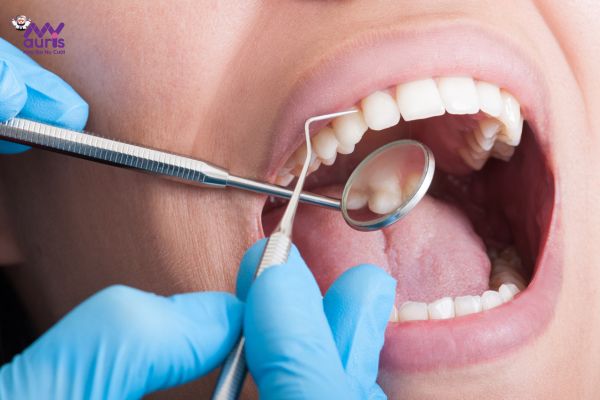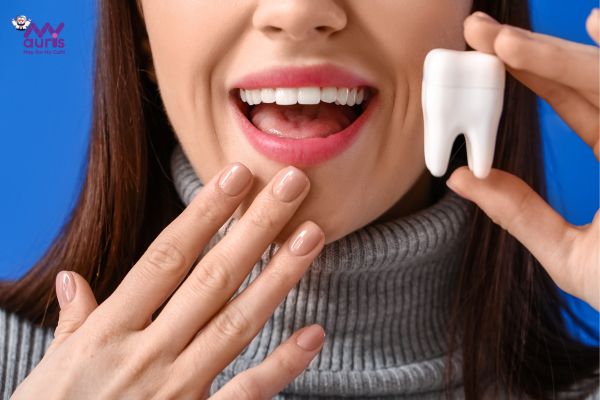Porcelain dental veneers are an aesthetic solution for porcelain teeth that bring perfect smiles to customers. Because porcelain veneers are thin and clear like real teeth, they bring natural beauty in both shape and color. Join My Auris to learn about the porcelain veneer process to better understand how to perform this method through the following article.
Learn about the porcelain veneer method
Porcelain veneers are less well known to customers than the porcelain crown method. However, this method was introduced to Vietnam 10 years ago. Porcelain veneers are also a dental technique to change the appearance, shape, and color of teeth.
The doctor will use a thin ceramic piece with a thickness of about 0.2-0.5mm to fix it on the surface of the tooth. And this restoration technique does not require much tooth grinding, and there are even cases where tooth grinding is not required.
Porcelain veneers are made from 100% pure porcelain, high-quality materials that ensure both aesthetics, color and firmness when chewing. Porcelain veneers help improve tooth defects in some cases such as:
- Broken teeth, chips not too big.
- Teeth are slightly discolored, yellowed, or dull. Because clear and thin porcelain veneers will not cover dark or severely stained teeth.
- Slightly spaced, protruding, underbite, and crooked teeth.
- People who want to improve their teeth shape and color to make them more beautiful. However, you must ensure that the tooth has not been damaged or undergone root canal treatment.

What is the process of porcelain veneers?
Porcelain dental veneers are not fussy, not complicated, and quickly fix defects on teeth. Porcelain veneer method follows the specific sequence of steps as follows:
Step 1: Examination, general check of oral health and CT Cone scan Beam
When coming to the dentist, customers will be examined by a doctor and have their general oral health checked for tooth color, tooth shape, and current tooth condition. After that, doctor sWe will order a Cone Beam CT scan to see if there is any dental disease, the extent of the disease, and whether the tooth pulp is affected and whether it has been treated. Based on the examination results, the doctor will plan appropriate treatment before applying porcelain.

Step 2: Treatment and consultation
In cases of mild tooth decay, gingivitis, periodontitis, etc. that do not affect the tooth pulp, the doctor will thoroughly treat the symptoms. In cases where root canal treatment is needed, the doctor will advise porcelain veneers because porcelain veneers will not be effective.
After the diseases are completely treated, the doctor will advise on tooth shape, color and porcelain material suitable for each customer’s tooth condition, needs and financial conditions.

Step 3: Teeth cleaning, anesthesia, tooth grinding
After that, the customer will have their teeth cleaned and anesthetized to thin the tooth surface about 02-0.5mm, without affecting the inside and two sides of the tooth. Under the effect of anesthesia, customers will not feel pain or discomfort during the procedure.
Step 4: Take tooth impressions
After grinding the teeth, the doctor will take tooth impressions and compare the tooth color so that the customer can choose the desired color. The tooth impression data will be sent to the lab to create porcelain teeth to suit the customer’s requirements.
During the time waiting for the teeth to be completed, the doctor will temporarily attach dentures to the customer to still ensure chewing and aesthetics. Temporary teeth are usually made from hard plastic.
Step 5: Try and attach the porcelain veneer
After the porcelain veneer is complete, the lab will send it to the dentist. At this time, the doctor will make an appointment for the customer to come to the dentist to try and officially attach the tooth. The doctor tries to attach the porcelain piece to the tooth to check the fit, shape, and color. Besides, customers also try the chewing feeling to see if it is firm and the bite is correcty not yet.
Accordingly, the doctor will adjust the position of the ceramic piece accordingly. If the crafted porcelain piece has errors in size or shape but is not tight enough, the doctor will send it to the laboratory for adjustment. In case the porcelain tooth has a standard bite and is satisfactory to the customer, the doctor uses specialized dental glue to fix the porcelain veneer on the outside of the tooth.

Step 6: Complete the porcelain paste and schedule a follow-up appointment
Once the porcelain veneers are applied to the teeth, the porcelain veneers process is complete. At this time, the doctor will instruct you on appropriate care, eating, and hygiene to protect your oral health and prolong the life of your porcelain veneers.
At the same time, the doctor also makes an appointment for a follow-up visit at the dentist to check oral health and the condition of porcelain teeth.
Thus, the time to apply porcelain veneers takes place quickly, without taking too much of the customer’s time. With this procedure, it only takes 2-3 dental appointments to complete the tooth bonding.
Notes before and after applying porcelain veneers
Process of applying porcelain veneers takes place according to the standards of the Ministry of Health, so customers can be completely assured if it is performed in a reputable place. However, to successfully apply porcelain veneers, customers need to pay attention to the following things before and after porcelain veneers:
Before porcelain veneers
- If you are pregnant or have any systemic disease, you should notify your doctor.
- Teeth and gums must be in a healthy state.
- Note: Although porcelain veneers grind teeth less and are not as invasive as porcelain crowns, once ground, the teeth cannot be restored to their original state.
- Choose a reputable restoration address, where doctors with good expertise, skills, and modern and advanced machines converge.
- Learn about the desired tooth shape and color as well as choose the appropriate ceramic material to prepare for the best cost.
After porcelain veneers
-
- Absolutely do not chew or bite food that is too hard or too chewy. At the same time, you should also eliminate bad habits of biting your nails, grinding your teeth, biting open hard objects, packaging… Because too much pressure will cause the porcelain to crack, peel,…
- Do not smoke because it is the main cause of dental diseases, and will quickly deteriorate the color of porcelain teeth. stickers.
- Maintain proper hygiene habits, brushing teeth regularly, using a combination of dental floss, salt water, mouthwash,…
- A nutritious diet should limit hard, sugary, acidic, and starchy foods because they quickly reduce the longevity of porcelain teeth. no leaks,…

Above is information about the porcelain veneer method, hoping that customers will have more knowledge and experience when applying porcelain. If you still have concerns, please contact My Auris dentistry immediately for more detailed advice and answers.
Anh Thy





